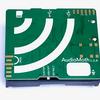Hi All,
I'm conducting a biodiversity survey that includes a grid of audiomoths. I have 53 deployed, with the following schedule: 15 seconds every minute, 4:00-12:00, and 16:00-24:00. 48kHz, medium gain. I was planning to leave all the audiomoths out for 30 days on this schedule, for a total of 120 hours of recording. I'm working in the tropics, so it's hot, never cold. The configuration app estimated a total energy usage of 60mAh per day (1800 mAh for all 30 days). I am using (3) new, freshly recharged, 2800 mAh nimh, low self discharging, rechargable EBL batteries per audiomoth, and have ticked the 'Use NiMH/LiPo voltage range for battery level indication' box. I should have been fine...
However, I am now collecting my first audiomoths that have been out for 30 days and they have only recorded ~12 days of data.
What happened? I was sure I'd be fine for battery capacity with 8400 mAh to cover my needed 1800. I'm guessing the audiomoths hit a low voltage cutoff? My batteries are 1.2V each, so 3.6V total. Should I disable the low-voltage cutoff with these batteries when I redeploy?
Looking to future sampling, I have tried to avoid alkaline batteries - it would be very wasteful with the amount of sampling and redeployment I have planned. Are rechargable lithium batteries the only way to go? Lithium mining is pretty bad though... What would be the most ecologically responsible battery, if nimh are out?
These kinds of batteries have been used successfully for many hours with Audiomoths:https://www.openacousticdevices.info/support/device-support/rechargeable-batteries
Is it my long schedule that is causing the issues (would continuous recording be more battery-efficient?)
Thanks,
Hubert
6 March 2024 6:49am
Am hoping to get some audiomoths in few months and worried that I'll run into similar problems given summer heat and humidity in the tropics. :(
hackerfarm.jp
This domain may be for sale!
6 March 2024 7:15am
You will be fetching and reusing the lithium batteries though wouldn't you?

Andrew Hill
Open Acoustic Devices
8 March 2024 1:17pm
Hi Hubert,
Your schedule looks good. Continuous recording would be less efficient and drain the batteries faster.
I'm wondering what SD card model and size you are using. The type of SD card and size has an impact on energy consumption. We've made a few measurements of different types on our website here.
AudioMoth batteries are connected in series. When in series voltage is multiplied, but amp-hour rating remains the same. With NiMH rechargeable batteries, AudioMoth might only achieve part of the amp-hour rating, the voltage discharge curve typically goes under the AudioMoth running voltage, this is roughly 70-80% of the battery life. You might only be achieving 1960-2240mAh in reailty.
It is better keep the low-voltage cutoff enabled, this will prevent batteries discharging completely, and will protect the SD card from running at very low voltages.
Thanks,
Andy
11 March 2024 4:49pm
Hi Hubert,
There's been some research into which batteries are most effective with ARUs, and there's some results here:
GitHub - kitzeslab/ARU_battery_longevity
Contribute to kitzeslab/ARU_battery_longevity development by creating an account on GitHub.
Battery quality can vary greatly, especially NiMh. Alkaline batteries can be largely recycled, reducing their environmental impact although being single use. The results above doesn't take into account SD card variation, but should hopefully be a good indication.


















Arky